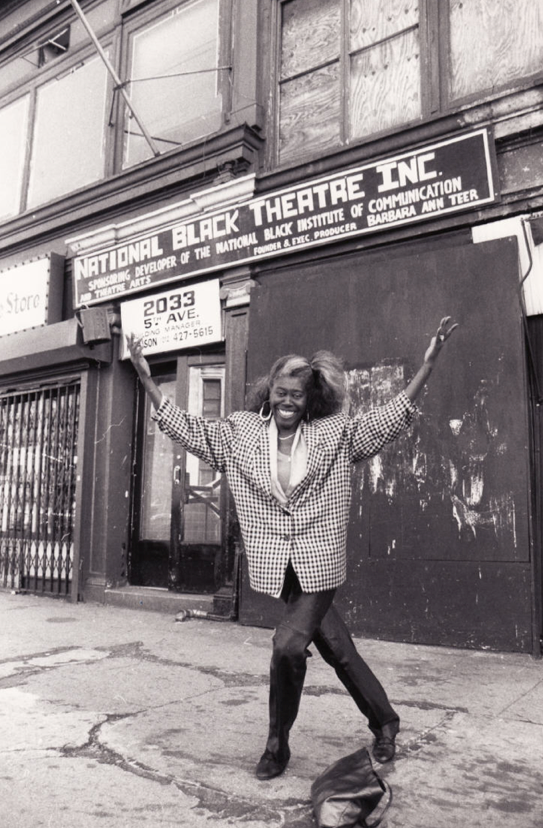“Barbara Ann Teer, unique; original; an artist in Life; and an artist at living life…she lit up the screen, the stage or anywhere she chose to be. There is not nor can there be another Barbara Ann Teer and no one can follow her or step in her footprints and fill them. The world is paled by her absence and the company of us who cared for her are weakened by her departure.” — Dr. Maya Angelou
Just before dawn. The phone woke me. How the conversation went I can’t quite remember—only the morphing of time and the release of a primal sound that eclipsed all feeling. In that fleeting moment my entire universe shattered into a billion unrecognizable, dazzlingly sharp pieces, strewn across the ether.
Just like that, she was gone.
Left with more questions than answers, a tangled pile of memories and instruction written in Braille, I would have to do the impossible and feel my way through all of it—the paralyzing fear, the premature departure, the gigantic shoes to be filled. She was the cheat sheet to my existential crisis. She held all of the answers.
Right there in front of me, cold as ice, lying in a box. My mom.
I prepared her body for cremation. (I know that sounds crazy, but it didn’t feel that way; it felt ancient and sacred, like a ritual deserving of a queen.) Unbraiding her hair and anointing her feet with sweet water, her best friend Ayo read her her obituary in the New York Times as we laughed and gossiped about all of the crocodile tears, truth speakers and remorse seekers that packed The Riverside Church that suffocatingly hot day in July for her funeral.
Shortly after her passing, this motherless child was charged to pick up the mantle of the groundbreaking legacy she had created, but legacy is a tricky thing. In order to move forward, let’s go back.
In order to move forward, let’s go back.

My mom, Dr. Barbara Ann Teer (Bobbie for short) was an alchemist. She could turn anything into something precious and worthy. As if born knowing her magic, she entered the world feet first, eyes open, with a streak of grey hair, and navigated the planet with vision and precision.
She was born to Lila B. Teer—a woman who wanted sons so badly she gave both her daughters boy nicknames and rough and tumble outlooks on the world. My mother’s bravery was, in some ways, a byproduct of being raised in the hood, by fearless parents who never spoke of glass ceilings. She would go on to graduate high school at 15, college at 19; to dance with Alvin Ailey, write, direct, act and finally, at the ripe age of 30 found the National Black Theatre (NBT) in Harlem.
In 1983, when the building that housed the theater burned down, she decided to buy the whole damn city block. (See? Magic.) NBT would go on to be the first revenue generating Black arts complex in America. It is currently the oldest continually run Black theater in New York and the theater in America longest-run by a woman of color.
Then there was me: a free spirit that had been running from my mother’s shadow my whole life, as most daughters do, to find my own light—until I ran smack into hers.
The first six years were especially daunting. Maya Angelou’s words from Mom’s funeral felt like a yoke around my neck—tethering me to the impossible task of being good enough, badass enough, revolutionary enough, magic enough, worthy enough. Enough!
I will be honest: I white-knuckled it through the days, months and years to come, pretending to be confident and capable enough to run NBT. But in May of 2014, when Auntie Maya herself passed, I revisited the words she wrote about my mom on the day of her transition and realized that they were not a prison sentence after all. They were actually the key to my freedom.
It’s impossible to live someone else’s dream or fill someone else’s shoes. How can you be anything else but an imposter if you try to wear the skin of anyone other than your own? Auntie Maya was right: My challenge wasn’t how big my mom’s shoes were; it was how small I believed my own to be.
The truth is, we each can only be who we are uniquely born to be. It hit me like a shot of cold air to the face after a mother’s last push that births you into the world. Instead of spending my time trying to imitate her shine, my time was better spent using Mom’s light to blaze my own path. Turns out this is how you keep legacy alive: you lean into the discomfort of the unknown, assured by your ancestors’ wisdom and grace and you bring all of you—unique, imperfect, wonderful you—to the table, to do the work you were born to do.
My mom’s passing became the ultimate gift, an opportunity to seek out my own brilliance in the midst of my bereavement. I found my unique purpose through her passing, that in each of us we hold the medicine to help heal our world.
Ten years later, NBT is thriving. As we celebrate our 50th anniversary, we continue to shatter the glass ceiling with groundbreaking award-winning work that heals communities and inspires the world. I am leading the charge on our new redevelopment project that will give NBT two new state of the art theaters in Harlem. Last November, we even opened The National Black Theatre of Sweden.
The sky truly is the limit, and I am loving owning my wings. As for my mother, she continues to unveil secrets to the universe to me—teaching me that life in order to fully live it, pushes you through countless excruciating birth canals that bring to your knees. Humbled. Devastated. Different.
New, but always divinely you.





